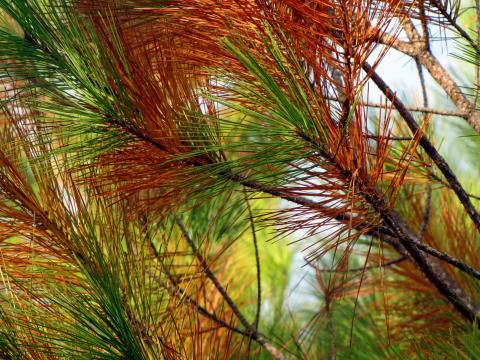September Gardening Tips

September Gardening Tips
Fall is usually regarded as the best time of year to renovate the lawn. Milder temperatures in mid-September should provide perfect growing conditions for grass to become established. Amend the soil and site conditions as needed before seeding: correct pH and nutrient deficiencies according to soil test results, reduce shade, improve drainage, and manage all weeds that will compete with new grass seedlings. Remember that irrigation is necessary to get a new lawn established.
September and October are good times to chemically control many perennial weeds. As these plants prepare to go dormant for the winter, sugars and nutrients are moved down to their root systems. Thus, systemic herbicides that are applied at this time are more readily drawn into roots. A systemic herbicide is one that is absorbed by a plant and transported through its vascular system, killing, or damaging the entire plant. By contrast, contact herbicides, such as horticultural vinegar, kill the part of the plant in contact with the chemical but the roots may survive, and the plant may regrow. Systemic herbicides tend to be the best option for perennial weeds, while contact herbicides are often effective against annual species. Before applying any herbicides, make sure to thoroughly read and follow the label instructions.
As production slows down in the vegetable garden, pull up spent plants, pick up all crop debris, and dispose of any diseased material in the trash. Several common vegetable diseases, such as Septoria leaf spot and early blight, will overwinter in crop debris in the soil, so it’s important to remove those materials from the garden to reduce infection next season. If possible, rotate where you plant vegetables in the garden next year. Multiyear rotations help limit infection because susceptible plants are kept away from soil-borne fungi.
Prepare houseplants for winter by pruning back excessive shoot growth and trimming roots that have emerged from pots. Carefully scout for pests such as spider mites and aphids and begin treating them before plants come inside. To reduce stress on plants, plan to bring them back inside a few weeks before you plan to turn the heat on so that they have time to adjust to lower light and humidity levels. Once plants are indoors and no longer producing lots of new growth, stop fertilizing until the spring.
Divide and transplant perennials. As perennial plants grow, they produce new shoots and roots around their periphery. Over time, roots and shoots begin to crowd one another and compete for water, light, and nutrients, resulting in larger perennial clumps but less robust plants. Some plants, such as daylilies, hostas, iris, ornamental grasses, and beebalm will develop dead or sparse centers as they become overcrowded. Additionally, restricted airflow amid dense growth can make some plants more susceptible to diseases. Dividing plants into smaller segments helps alleviate competition between roots and shoots and often results in new growth and more flowers. Fall is a good time to divide perennials because the weather is typically cool and wet, reducing plant water loss and stress after being transplanted. Aim to divide and transplant at least eight weeks before the ground freezes, to give plants plenty of time to become established.
Black, purple and red raspberry canes that fruited can be pruned to the ground in the late summer or early fall. This gets rid of a disease source and gives the remaining “primocanes” room to grow. Also, remove any new canes that are growing outside of the planting bed, and any that are very weak or diseased. In the spring, thin the primocanes, leaving only five to seven of the sturdiest per hill for black and purple raspberries, or four to five canes per foot of row for red raspberries.
Seasonal loss of inner needles on evergreens is normal in the fall. Evergreens go through a natural cycle of dropping and replacing old foliage just as deciduous plants do. They just do it on a slightly different schedule. While a maple tree will only keep its leaves for a single growing season, a pine tree may hold onto its needles for two seasons. Eventually, needles become old and worn and drop from the tree naturally. The oldest needles are those that are closest to the trunk along a branch. These are the needles you should expect to turn yellow or brown and drop from trees and shrubs in the fall. Pines, hemlocks, spruces, and arborvitae shed some needles in the fall every year and produce new needles the following spring.
Do you love learning about stuff like this?
SUBSCRIBE TO GRANITE STATE GARDENING
A monthly newsletter for New Hampshire gardeners, homesteaders and plant-lovers of all kinds, that includes seasonal suggested gardening tips, upcoming events and articles with proven solutions for your garden and landscape.
Got questions? The Ask UNH Extension Infoline offers practical help finding answers for your home, yard, and garden questions. Call toll free at 1-877-398-4769, Monday to Friday, 9 a.m. to 2 p.m., or e-mail us at answers@unh.edu.
